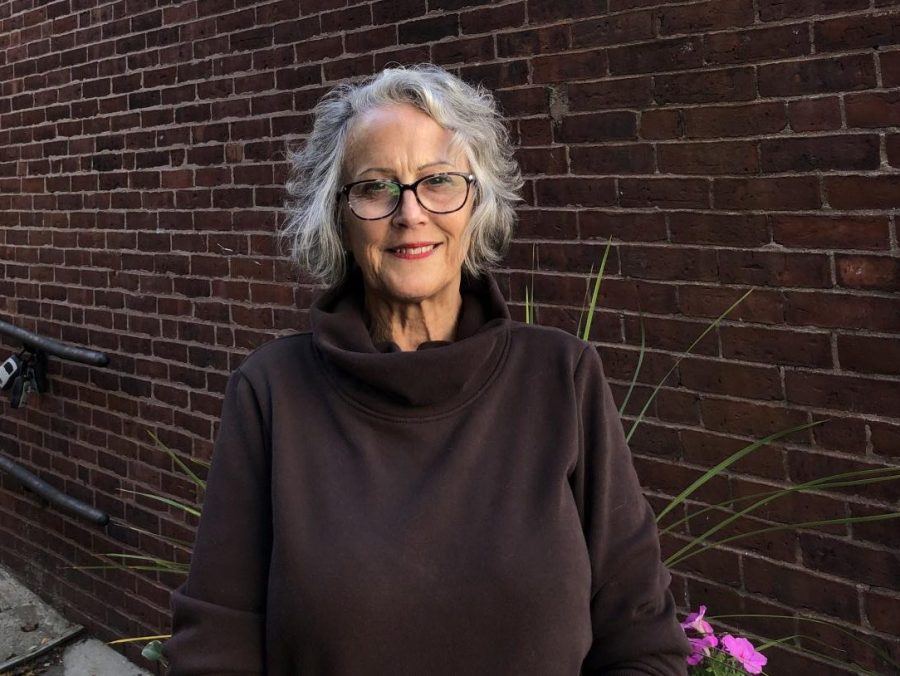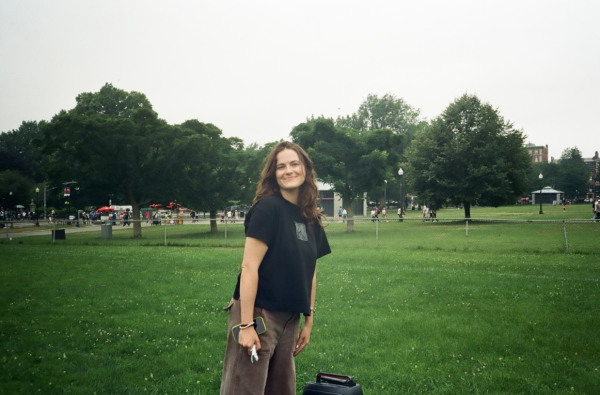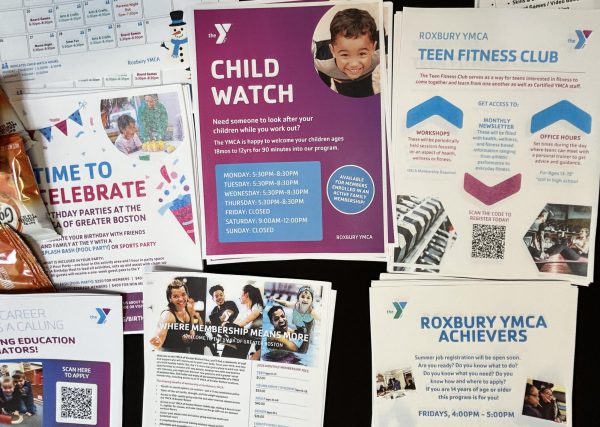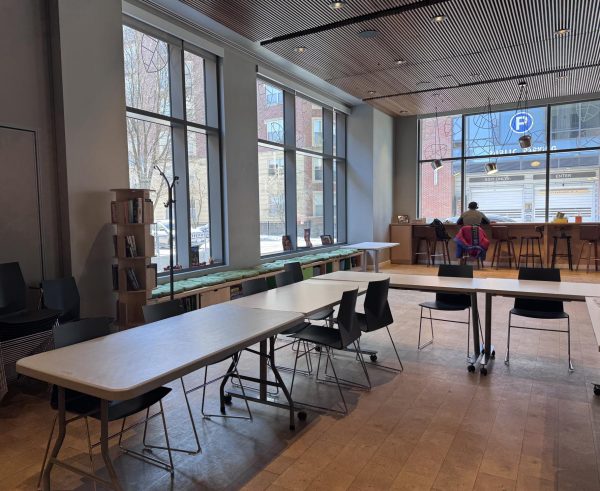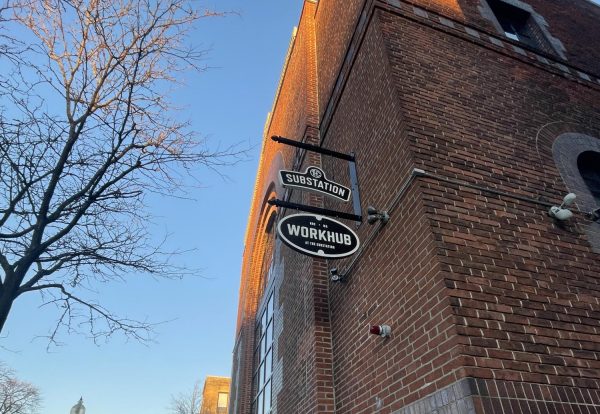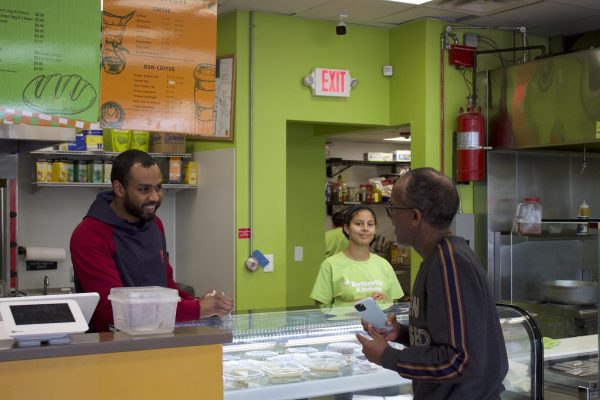“We did not lose one business during COVID”: Mission Hill Main Streets celebrates 25 years of neighborhood resilience
“I think you’ll find that in Mission Hill, people are much more accepting.”
Photo: Kelly Chan
Mission Hill Main Streets executive director Ellen Walker outside the festival last month
The backbone of the Mission Hill community sits in a small alleyway on Tremont Street, a nonprofit organization called Mission Hill Main Streets. Mission Hill Main Streets, or MHMS, focuses on inclusive community-building, strengthening the neighborhood’s business district, and preserving Mission Hill’s history.
This is one of 20 Main Street organizations in Boston and is part of Main Street America, a national program of the National Main Street Center with hundreds of local branches across the country.
In September, MHMS celebrated its 25th anniversary, with executive director Ellen Walker at the forefront. Walker, who has been in this role for three years, has seen the neighborhood’s resilience, especially through the COVID-19 pandemic, and is now watching the community thrive with younger generations being drawn into the area and preserving its vibrant diversity. One of her goals this year is also to make Mission Hill a more accessible and safe urban landscape for all residents and visitors.
The Scope recently spoke with Walker to describe the anniversary event, the organization’s work, and how Mission Hill has grown. The following interview has been edited for length and clarity.
Could you give a brief background for the readers about MHMS and the work that you do?
Mission Hill Main Streets is 25 years old this year, and the goal of Mission Hill Main Streets is to support economic development. We work with small businesses, but we also support the residents and the community organizations here.
There’s also a historical component to what we do, so if there’s a way to help maintain historic homes, businesses, or facades, we work with that as well. For example, one of the things we are trying to do is revive the historical commission in the area, and recently, some of the residents really took the challenge and made sure that the commission came back to life.
What did your 25th Anniversary celebration look like?
The goal was to celebrate being here for 25 years and to recognize the community while doing that, so that was our driving factor the entire time. We made sure that things were going on for young children, youth, seniors, people interested in history, and people interested in sports and fun activities.
Most of our events took place at the Tobin Community Center, a core area for the families in Mission Hill. In order to try to draw everyone in, we arranged for tours of the Mission Hill Church — and whether you’re religious or not, the Mission Church is a central theme within Mission Hills because you could see it from almost anywhere and the hills. We also did historical walking tours as well of the area, and because we wanted that piece to continue beyond the 25th event, we’re putting them up on our app as well as our website so that we can further promote that side of Mission Hill.
We had 17 restaurants donate food. We had two basketball games back to back. And then, on the far side of the Tobin, we had activities for younger children, including fabulous face painters, this guy with a little pony, and we had Wonder Woman and Spider-Man show up. The Boston Police Department even came by with free ice cream for everybody. There were a lot of things going on, and it just drew probably a couple of hundred people during the course of the day.
We think it was very successful, and maybe a few extra people learned about Mission Hill and what we have to offer on a regular basis.
What did this celebration mean for the community?
I think they appreciated the different facets of it. Not everybody went to everything. I believe the piece they went to spoke to them and that it recognized what they were looking for — some type of connection.
We’ve had a few new people who reached out to us, which is part of the goal to make people aware that we are here and that there are so many things to do and participate in. So it was just a lot of new connections for a lot of people, and it’s up to us to reach out and make sure that those continue.
What’s the biggest change that you’ve seen in Mission Hill?
We’ve always tried to be as inclusive as we can. And I think that’s where Mission Hill has changed the most.
A lot of people know about its history in the ’60s and ’70s and how it was not a great place to live. There was a lot of tension, and there was a lot of fighting between the different ethnic groups that were here. But I think that you’ll find in Mission Hill, people are much more accepting, and it’s much more of a blend. Everyone is everywhere, which is really important.
The majority of the businesses, probably 70 or 80 of them, are food service, and of those 70 or 80, probably 60% or more are owned by immigrants or minorities. And it just enriches the entire area. We’ve got everything here. We really do.
What is something you’re proud of since you’ve been in this role?
We did not lose one business during COVID. That’s huge. Brigham and Women’s Hospital and New England Baptist Hospital invest in the community. The Brigham and Women’s Hospital came to us, and they bought gift cards, thousands and thousands of dollars of gift cards from all the local restaurants. (Most of them didn’t have them, so we had to make up for them.) But everyone who got a COVID test got a bag with things to help protect their health. There were little gift items, and then you had a gift card from a local business.
We’ve got these world-class institutions around us, and they are part of the community; they are really invested in what’s going on here. The hospitals and institutions are really making a huge effort in the past year, trying to connect with the Mission Hill neighborhood.
And this year, one of the things I’m proud of is we’ve always been connected with the Museum of Fine Arts. This year, for the first time ever, we’re able to commit Mission Hill artists to be a part of the first Community Day every year. So May 31 is a free community day [at the museum]. We had three artists set up in the atrium to let people know about Mission Hill and to let people know about the different types of art here.
How do you plan on continuing to grow and improve this organization?
One of the things we’re looking at is what we can do better. How can we do things differently? What should we change? We try not to do the exact same thing every year, but we do have set things we do for the community, and we try to just make it better every year. The Museum of Fine Arts component, for example, was a new thing we’re able to add this year, and we expect to see change with the historic commission now being active, just getting their feet together. All these little pieces are moving forward, involving different parts of the community, and it’s just great to see that.
We also spent a lot of time and focus on our social media. We’ve gone from 475 followers on Facebook to over 6,000 between Facebook, Instagram, and Twitter. We’re trying to reach out to a younger generation to interest them, especially with the things that we’re doing on Instagram and Twitter, and considering getting into TikTok.
What other events do you have coming up?
We have specific events that we do, but we also support what’s going on around us. There’s a Farmers Market three times a week, Tuesdays and Fridays at Roxbury Crossing and Thursdays at Brigham Circle.
The Tobin Community Center has the best Halloween event for families, called “Halloween on the Hill.” They’ve been doing it for years, and they get about 400 people to show up. It’s amazing. The young people that are part of the Tobin Community Center create the spooky house, and the lines go out around the corner.
On Veterans Day, Nov. 11, we do a wreath-laying ceremony. Mission Hill Post 327 shows up in the Colonel’s uniform, and there are a couple of speeches and activities that bring in the soldiers that are there and pay respect to those who have passed.
What do you personally look forward to the most? Is there anything about the future of Mission Hill Main Streets that particularly speaks to you?
I don’t know if there’s any one thing. I think just taking the events we’re doing and making sure that we’re tweaking them to the new audience and the way people respond to things is key. It’s exciting.
We also have another ribbon cutting coming up. We have a new business [Yellow Door Taqueria] opening this month. And the exciting part of watching all these business owners — whether they’re established, the second generation, they’ve been here for years, or they’re brand new, and they just come up through the ranks for the past two or three years — is the flexibility and the creativity of the people that are involved here. These business owners are truly remarkable because they keep adjusting their business plans and keep making changes. It’s just such a positive feeling to see them succeed and to watch how they’ve achieved that, and to watch them learn and grow.


